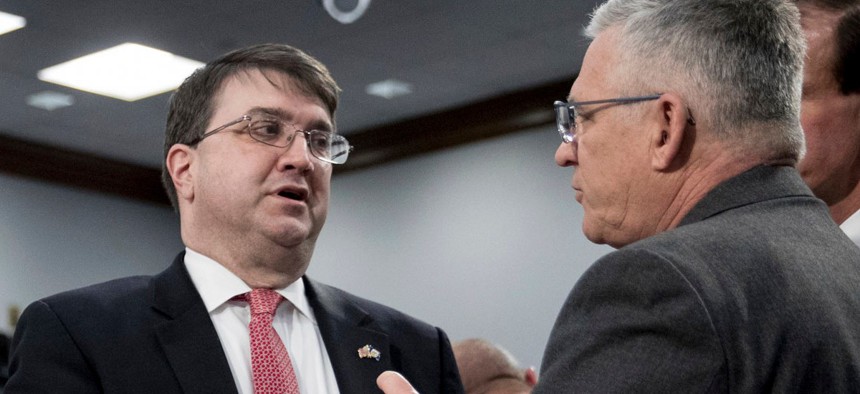VA Expects 'Hiccups,' but an Otherwise Seamless Health Overhaul This Week

Veterans Affairs Secretary Robert Wilkie, left, speaks with Veterans Health Administration Executive in Charge, Dr. Richard Stone, right, before a House Appropriations subcommittee hearing on budget on March 27. Andrew Harnik/AP
Some lawmakers and veterans groups are nervous about VA's implementation process for the new private care program.
Officials at the Veterans Affairs Department acknowledged there may be a few glitches as VA rolls out a sweeping overhaul to its delivery of health care services this week, but overall, they said veterans should experience a smooth transition to the new system.
June 6 will mark the one year anniversary of President Trump signing the Mission Act into law, as well as the deadline for VA to implement the changes it requires. Congress passed the measure on a bipartisan basis in an effort to consolidate existing private care programs and make it easier for more veterans to access non-government providers. Despite the widespread support for the compromise legislation, the law has since faced pushback from detractors who have accused VA of implementing it without transparency and as a first step to privatizing the department.
In a C-SPAN interview over the weekend, VA Secretary Robert Wilkie said the department is ready for the sweeping changes that will take place later this week following a final regulatory posting from the department.
“We do expect on June 6 to be ready,” Wilkie said, adding he will treat it like “just another day at VA.”
Wilkie said he has traveled to many VA facilities in recent months to personally verify a seamless transition, though he acknowledged some veterans are likely to encounter problems.
“I’m confident our team is ready across the country,” Wilkie said. “There will be a few hiccups, but there always is in an organization that has 370,000 employees.”
The department earlier this year unveiled standards for accessing private care under the Mission Act, which would enable veterans living more than a 30-minute drive on average from the nearest VA facility to use a pre-approved network of private providers for services such as primary care, mental health and non-institutional extended care. For specialized care, veterans must live outside of a one-hour drive from the nearest VA facility. The law will also enable vets to access private care if the services they require are not available at their VA facility, they live in a state without a full-service government facility, they qualified under the previous Choice Program, their VA facility is not meeting quality standards or their doctor decides it is in their “best medical interest.”
Wilkie said VA has been proactive in ensuring the private sector doctors who will be part of the new network are prepared as well, vowing to avoid the reimbursement issues that have plagued previous efforts to provide private sector care for veterans.
“We have been out in the field with information and training to doctors and medical centers across the country,” he said.
The secretary suggested VA employees would find it easy to schedule private sector care due to a new program the department has developed, describing it as a screen that “pops up” that enables the medical professional at VA to tell the veteran what is available in the area and immediately press a button to book it.
The U.S. Digital Service in March flagged VA’s efforts to launch new tools to support Mission Act rollout as behind schedule and potentially delaying care. VA officials told lawmakers in April they were moving forward with those new tools, but conceded the department may have to make adjustments—both to its IT systems and the new private care system writ large—on the fly.
“I’m not going to sit before you and say we are going to get everything right on June 6,” said Richard Stone, the executive in charge of the Veterans Health Administration. “There is going to be something that doesn’t go in the right direction and we’ve got to get corrected.”
Some lawmakers pushed VA to delay its implementation date, but department officials declined to adjust the plan. In a recent release, VA said veterans “should expect a fairly transparent and seamless transition to the new Veterans Community Care Program,” noting the existing Choice Program will cease to exist. Veterans service organizations have complained, however, of an opaque rulemaking process that excluded veterans groups.
Dennis Nixon, national commander of Disabled American Veterans, told Congress earlier this year that “the development of the VA access standards has not been an open or collaborative process up to this point.”
B.J. Lawrennce, commander in chief of Veterans of Foreign Wars, warned that VA is setting itself up for failure.
“While we are glad VA has finally published its plans for the access standards, we are disappointed VA chose not to incorporate the voice of our 1.6 million members in the decision-making process,” Lawrennce said. “As a result, VA is repeating previous mistakes.”
Some members of Congress have expressed similar concerns, saying VA stopped working with them after the reform’s passage. They also said the department has not adequately budgeted for the costs of sending more veterans to the private sector for care or planned for a surge in the program’s usage, which could to lead to diminished resources for VA’s own internal network, the critics have warned.
Wilkie pushed back on those allegations, saying he recently proposed the largest budget in VA’s history, including growing the department's workforce to 390,000 employees.
“We’re not in a pathway to privatization because if we are, we’re doing it in a very strange way,” Wilkie said.
VA also predicted no significant addition in the number of veterans who opt for the private sector.
“VA employees are passionate about caring for veterans and are highly experienced in meeting veterans’ specific needs,” the department said. “Because of this, VA believes veterans will continue to choose VA.”
NEXT STORY: Lawmakers push on AI in draft defense bill






